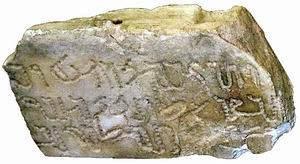Petra
Site of Ancient Edom
By Ferrell JenkinsPublished in Biblical Insights
February, 2004The Treasury (El Khazneh) is the most exquisite Nabatean building in Petra. The Corinthian columns are 50 feet high. Photo © Ferrell Jenkins 2004.
Petra
by Ferrell JenkinsPetra is probably one of the most beautiful, and most unforgettable places one will ever visit. It is located about 50 miles south of the Dead Sea in the territory of ancient Edom. The first visit I made to Petra in 1967 was from Jerusalem (then in Jordan). The distance from Amman or Jerusalem depends on the route you take. The Desert Highway, which connects Amman with Aqaba, is much faster, but the old Kings Highway is much more scenic.
Petra is the Greek word for rock, and is likely to be identified as the biblical Sela, which also means rock (2 Kings 14:7; 2 Chron. 25:11-12; Isa. 16:1; 42:11; Jer. 49:16). This region was also known as Mount Seir. The ancient city is located in the basin of Wadi Musa at an elevation of about 2700 feet, and must be reached by foot or horseback through the Siq (Arabic for pass).
A small Edomite stronghold dating to the Iron Age (7th-6th century B.C.) has been found on top of Umm el-Biyarah which is a high, steep-sided, flat-topped hill in Petra. The Edomites were displaced by the Nabateans and moved into the region of southern Judea. In New Testament times they were know as the Idumeans (Mark 3:8).
This Greek and Nabatean inscription found at Jerash in 1931, tells of a statue dedicated to Aretas IV. Amman Museum. The Nabateans have been described as "one of the most gifted and vigorous peoples in the Near East of Jesus' time" (Wright, Biblical Archaeology 229). They exacted high tolls from the caravans which passed their way. The greatest king of the Nabateans was Aretas IV (9 B.C. to A.D. 40). His rule extended as far north as Damascus during the last part of his reign; this was at the time Paul escaped from Damascus (2 Cor. 11:32).
Herod Antipas ("that fox," Luke 13:32) left his wife, a daughter of Aretas, to marry Herodias (Mark 6:17-29). When the rejected wife fled to her father, he sent an army to defeat Herod in A.D. 36.
The chief deities of the Nabataeans were the sun god Dushara and the goddess Allat. Dushara was symbolized by a block of stone or a stone obelisk. Several can still be seen in Petra.
The Roman emperor Trajan conquered Petra in A.D. 106 and converted it into the province of Arabia. The Romans continued the rock sculpturing of the Nabataeans but added a theatre, a street with colonnades, etc. Some have speculated, on the basis of Galatians 1:17, that Paul spent time at Petra after his conversion to Christ.
The photo shows the Roman theater at Petra. The theater, cut from the native stone in the second or third century, seated 3,000.
Photos © Ferrell Jenkins 2004.
The photos may be used by others in teaching, but may not be used commercially or on web sites without permission.


